Creators, Community and Gray Space in the Middle
Abstract: A detailed introduction to community tokens such as RAC, the author is a well-known technology reporter
The text begins:
Original title: Creators, Communities, and the Gray Space in the Middle
Original link: https://www.nichanank.com/blog/2020/10/9/gray-space-in-the-middle
Word Count: 2997
Author: Nichanan Kesonpat
Translator: La
Proofreading: StampSoda
Translation agency: DAOSquare
Interviewer: "It's just a tool, isn't it?"
David Bowie: "No, no, it's an alien-like form of life."
Bowie presciently described in 1999 what the Internet would mean to the music industry. In particular, how the Internet will change the relationship between artist and audience. At the time, he realized that humanity was on the cusp of something both exciting and terrifying: breaking down barriers between creators and their communities. Art or information is no longer one-way to the audience, but more communication, the audience comes in and adds their own interpretation, and the creator's work is complete. There, the work evolved, a kind of sampling remix that the creators could not have imagined. Bowie calls the place where creators and their communities come together as the "grey space in the middle": a powerful new area of engagement where the most interesting things happen, and Bowie predicts everything that will happen in the 21st century will happen in this space .
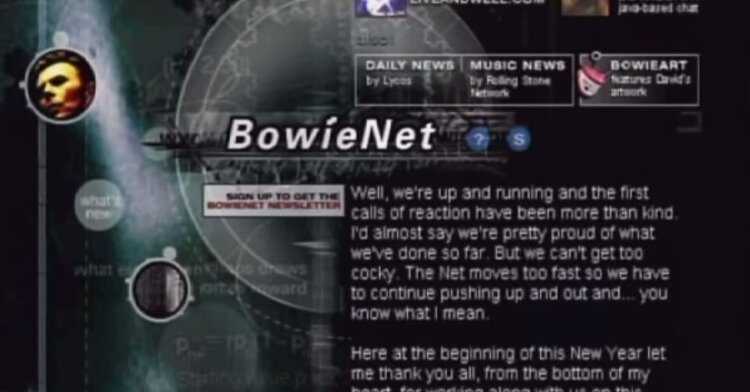
A few years before exploring the possibilities of the "World Wide Web," Bowie launched its own Internet service provider, "BowieNet," in 1998, which, in addition to its core services, served as a platform for an early fan community. Fan platform services include a personal email address (yourname@davidbowie.com), access to exclusive Rolling Stone music, exclusive content, and online chat with Bowie and his friends.
In 1997, Bowie streamed his Earthlings concert for the first time in Boston, giving fans around the world a live experience. While most people don't have fast enough internet speeds at this time, it sends a signal...

April 2020: More than 12 million people watched rapper Travis Scott's virtual Fortnite concert online.
Let's look at some examples of what is manifesting out of the gray space in the middle in 2020.
I watched Bowie's interview and couldn't help but think about what's been happening recently with NFTs and community tokens. New users interact with web3 applications for the first time not because they want a steady stream of money, but are seduced by beautiful artwork, music, NBA clips, games that make money, community ownership, and a sense of belonging. It feels like we are entering the next evolutionary stage of online communities, where you and others are not just members of the same chat room talking about mutual interests, in a system that has self-marketing incentives to reward the value of your contributions, It is also a stakeholder in the community itself. The community can evolve a product with the creator. As Bowie observes, at least the audience has become as important as the artist. Today, users of decentralized protocols are at least as important as those who write code, and holders of community tokens are at least as important as those who issue tokens.
Let’s take a look at some examples and see how the gray space in between is doing in 2020.
Audience-led price discovery
Zora is a platform that lets creators place limited-edition artwork and merchandise as crypto tokens. One token redeems one unit of real-world product. What does it mean?
Placing an item on Zora generates a cryptocurrency that represents the item. If you want to give up 100 pairs of sneakers, 100 tokens are created that can be bought and sold on the internet. This allows physical products to be priced based on changes in supply and demand in the open market.
Tokens start with a base price, and then the token price goes up and down as people buy and sell. This means that you have the opportunity to sell the tokens back to the market at a profit or loss before you can exchange the tokens back to the actual product, and the transaction fee goes to the original author.
When someone exchanges tokens for real-world items, creators earn at current market prices. Tokens used for redemption are destroyed and permanently removed from the market. People who exchange tokens receive products sent to them.
In their introductory blog, Zora argues that this solves what they call "The Yeezy Problem". Yeezys is a sneaker sold by Kanye West and Adidas for $220. But because the shoe was in short supply, the sneakers were selling for 10 times the price on secondary markets like StockX, and the original creators didn't make any profit from them. With a platform like Zora, creators can create their own marketplace to discover their true price and be able to reap some benefits from subsequent marketplace activity.
Andre Anjos, also known as RAC, is a Grammy-winning artist and one of the most outspoken supporters of web3 when it comes to innovative revenue streams for artists and their communities. He collaborated with Zora on his third studio album, The Boys, and released a limited-edition cassette in TAPE format, priced with a dynamic price curve. Prices for TAPE started at $20 and quickly rose to a few hundred dollars as people flocked to participate in experiments to discover the price of music. Below is an overview of all operations.

Create a public limited-edition merchandise marketplace using the blockchain.
This is just one example of creators leveraging crypto to create their own marketplace. Note that these restrictions are currently limited to limited-edition items with a fixed supply. In many cases, fixed pricing makes more sense. In most cases today, the price of a commodity and the reduction in revenue to the artist are determined by a multitude of middlemen, and the audience just has to go with the flow. Platforms like Zora and Foundation upend that model, answering our question: If you only make a limited amount of something and open it up to the market, how much is that thing worth?
This is the market price of $TAPE on Zora on October 8, 2020
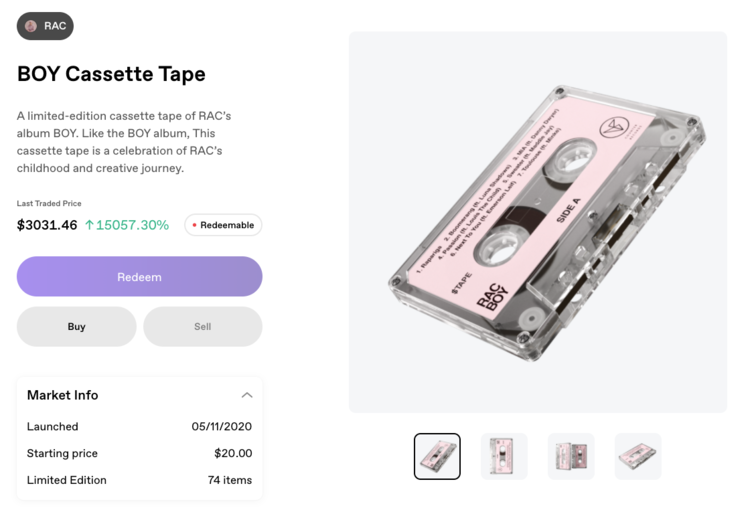
$TAPE product page on Zora
Here's a screenshot of PLS&TY's limited-edition EP on Foundation, another marketplace, with redeemable tokenized commodities and price curves in a similar fashion to Zora.

$PECIAL product page on Foundation
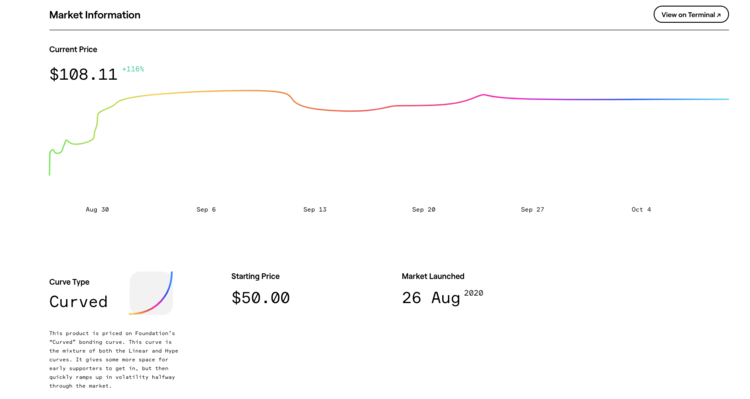
Price Curve of $PECIAL
Meanwhile, creators have a community of Patreon subscribers, Bandcamp supporters, Subreddit hosts, and fans around the world who spread the word about everything they do. Of course, these stakeholders are at least as important as the companies that publish these records. However, they are the only ones who have not had the opportunity to gain the value of their contributions to the art project. How can we do better?
Community ownership of an art project
Did you ever support a band or artist when you first started out? Whether it’s a YouTuber with hundreds of followers who stumbled across and has always liked, or a friend who started a high school band and sent everyone an EP recorded at home in class. The art project (YouTube channel, visual arts, music) grows a fan base or community sharing that creates a sense of like-mindedness and pride. I still remember the first Smosh video I saw and embedded on the Piczo website. For a solo creator just starting out, a platform like Patreon allows people to support a project. Some even donate not only money but also time to promote it. Aside from member information and face-to-face interaction with creators, they really have no incentive to put in the time unless they value the project and want to see it continue. What if there was a system that would allow a community of backers to enjoy a portion of a project's successful outcomes while rewarding the most valuable members?
The idea behind Community Tokens is that creators can open up ownership of a project to a variety of people, then incentivize them to improve the project together. With the support of artists and curators, we are no longer an intricate intermediary relationship, and we now have the technology to experiment with more transparent, inclusive and open mechanisms for monetary transactions and monetary monetization.
Now, creators can not only interact directly with fans: the community can also express their opinions and have more opportunities to be heard, perks can be designed to reward those members who contribute the most, and the community can also express their opinions through token ownership and availability. Redeem real-life rewards to benefit. Creators go from indifferent entities behind the veil of corporate interests to active participants in their own communities.
It's a disenchantment between artist and audience. Most prominent social tokens today are ERC-20s on Ethereum, which are freely tradable on the blockchain. Of course, there are also markets for these tokens, and some do so without participating in the community itself. But those who earn tokens through active participation invest not their money, but their time and commitment. For them, holding a community/social token means choosing to join a community that benefits both token holders and users. A token is a tool, not a financial investment. For example, a tiered membership model would require you to have X amount of tokens in your wallet to gain access to a private Discord channel for exclusive content, qualify for giveaways, or early airdrops. Because ownership is on the verifiable chain, checking your eligibility is trivial.
The following is from the community token RAC announced last week:
“Historically, artists have been denied the opportunity to capture their own value because they have been monopolized by a host of intermediaries, such as companies and platforms, to monopolize the ownership of their creations. For many years, I have been fascinated by crypto and its addition to money application and believe it can create a new model of creative ownership directly between artists and their communities. This new paradigm is what I want to pursue with $RAC and I want to bring it to my existing fans and in the hands of the community.”
“ RAC is a token built on Ethereum and I want to give it to the fans who support the RAC project and those who want to grow it with me. By rewarding my most loyal fans, we can create a community where Tokens unlock access to various perks and exclusive content. Crypto enables communities to capture the value they create, rather than being monetized by platforms that already exist, and RAC is an active experiment that unlocks these fundamental things secret."

Reissue tokens allocated to RAC supporters
Now, when an artist gets a record deal, the company offers a service that actually stakes the artist's success. Make that bet, they own the project, and they recoup their money and make double the money. What does a musician's world look like when their community is a record company?
In other words, what happens when fandoms can get artists to finish their work ahead of schedule and get the financial benefits of the project? Of course, the creator must be responsible for delivering the work. But once trust is established with the creator, if you like their work, why not own a piece of it yourself? If people can buy stock in a company, why can't they buy stock in an art project?
Until a few years ago, many of these concepts remained at the theoretical stage as separate primitive concepts. Right now, the web3 infrastructure is far from complete, but we're at a stage where we can start implementing these primitives as code, putting them together like building blocks, and experimenting a lot to see verifiable scarcity Whether sex, open market volatility, and data distribution can eliminate the social and economic inefficiencies left in the system.
programmable art
Projects like Async Art are pushing the boundaries of data art ownership and allowing data art collectors to influence the work itself. The original artist sets a series of parameters that can be changed by the owner of the different "layers" of the artistic NFT. So if 5 collectors own 5 different aspects of a tree picture. One collector can choose to get its ripe fruit, another can rearrange its branches, one can control the weather... In this sense, the whole work becomes the original creator and those who care enough about the artwork to buy a part of it Collective expression of collectors of works.
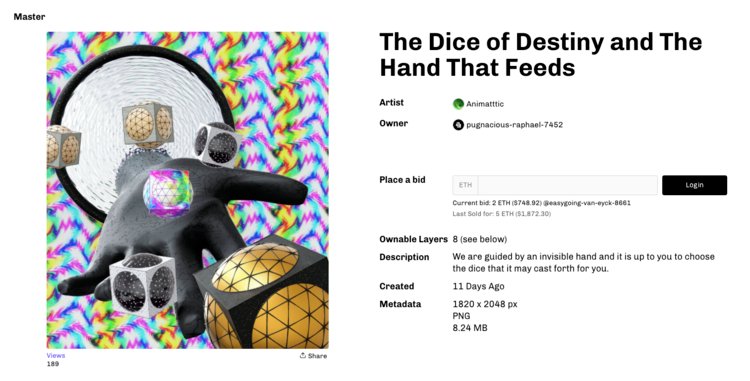
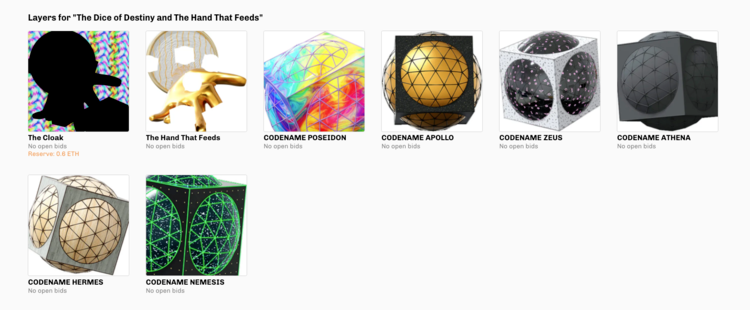
Artist Matt Kane, who uses algorithms and his own human input to create unique, intricate colors and patterns in his work, allows collectors of his tokenized section to log into a collector-only area that contains exclusive Behind-the-scenes content and draft work produced during the final product process. After logging in, the collector needs to connect to the website using their browser crypto wallet, which then detects if the person owns the NFT. If the person decides to sell the artwork, the next owner of the artwork will automatically gain access to the collector's area. Interestingly, over time, more and more creators are using tokenized access to design perks parameters for “Walking”, cultivating and curating engagement with fans in a way that wholesale third-party platforms have never had before. group intimacy.

Some of the tokenized work displayed on Matt Kane's website
shared visual space
I've written before about non-fungible tokens and NFT projects that are now pushing their limits. Let's review the fact that NFTs temporarily serve as virtual land. Right now, the ownership model is simple, an NFT owned by one person represents a piece of land on which that person has the right to build or grant building rights, or sell the land on the open market.
What happens when members of a community can own their own virtual land?
Decentralized Autonomous Organizations (DAOs) are collectives of individuals with a common goal who can decide how to allocate a set of common resources. Can make for-profit investments or provide mandates to projects with delegated tasks. It can provide services or curate data art.
Cryptovoxel land is NFTs on the Ethereum blockchain. Today, it's home to art galleries, impressive commissions, weekly gatherings, and even a sorority. There's also an in-community "Metalympics" game here on November 5th!
What happens when a group of artists and curators come together, buy a virtual piece of land, build a gallery, and decide what work should be shown in the next exhibition or what concepts can be curated around it? Anyone can enter a URL in a browser, then browse, discover and buy the data artwork NFTs on display or a digital representation of a real-world product, and tokens can be exchanged for data products or even real tangible products.
The first community-owned land experiment is the ZOO token, where ZOO represents fractional ownership of CV land representing the Bronx Zoo. ZOO is also used as a governance token, where holders can vote on what to do with community funds. In a few months, the land will be auctioned off, and $ZOO token holders can claim a pro rata portion of the sale. This is what the zoo looks like now:
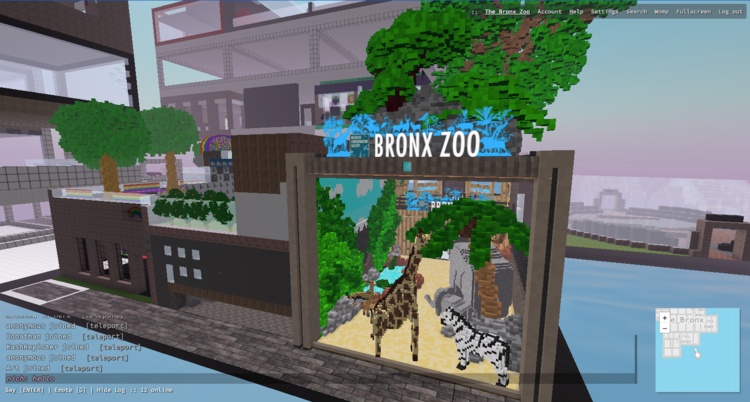
Check out the zoo scene from the WIP Meetup a few weeks ago!
This topic deserves a series of related articles, which I save for later. But if you're interested and you want to see the results of some recent brainstorming on NFTs, check out the ongoing Untitled Hackathon, which doesn't end until the end of the month.
David Bowie observed that in music, there wasn't a single "era representative" artist in the '90s like the Beatles in the '60s, or Elvis in the '50s. In the 90s, people flocked to different genres and music became more popular: there was hip hop, grunge music, girl power... more and more about the audience and the culture of the genre. At carnivals, DJs accompany the audience and respond to what the audience is doing, rather than a static one-way communication. The experience of the carnival scene is created by the audience and the DJ. He deeply understands the connection between artists, fans and culture. He sees the internet as an art venue. He was excited to see what the "new structure" between artist and audience would look like in this gray space in between.
Now, more than ever, we have the means to explore and amplify our own differences. We can be experts on LinkedIn, foodies on Instagram, comedians on TikTok, motivational speakers on Twitter, or anonymous contrarians on Reddit. Likewise, we can connect with like-minded strangers and collaborate towards a common goal. When it comes to self-expression, the internet has allowed us to create something meaningful with people we may never have seen in real life: whether it's supporting a YouTube channel with millions of subscribers, or attracting a lot of attention and A cause supported by funds. With web3, we can now process not only information but also value, allowing us to co-create and grow creative projects and own a part of the project's successful outcome.
I will continue to explore the strange and wonderful things that emerge from this intersection of creativity and the wider public. If you enjoyed this and previous forays into the future of arts, entertainment and online communities, please subscribe! Who knows, it might spark a conversation and then light up something in this gray space in the middle.
Now, listen to Bowie talk.
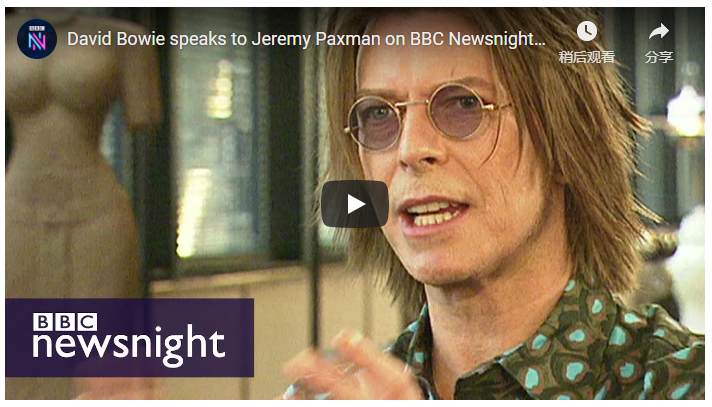
Like my work? Don't forget to support and clap, let me know that you are with me on the road of creation. Keep this enthusiasm together!
